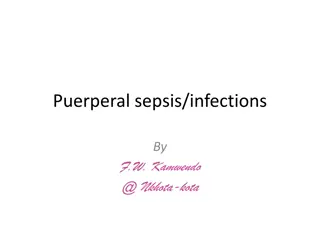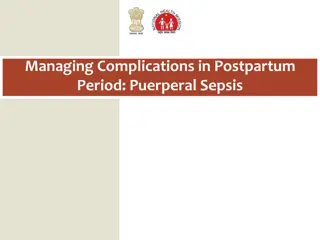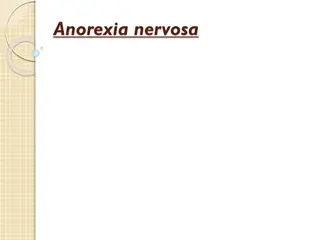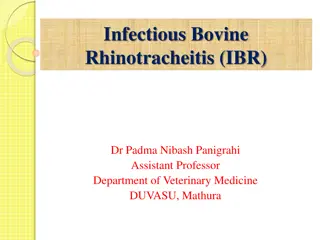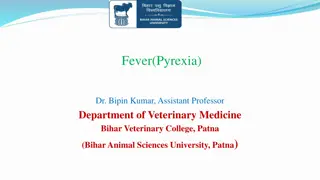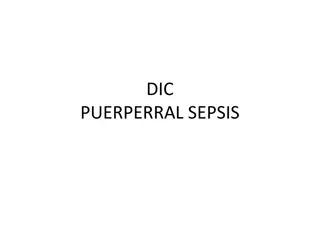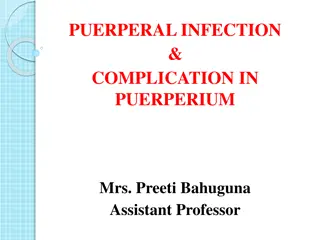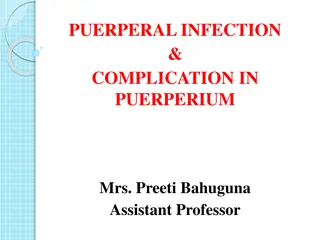
Understanding Puerperal Pyrexia and Its Risks
Explore the causes, symptoms, and complications of puerperal pyrexia, a fever occurring in women within six weeks postpartum. Learn about different types of postpartum infections and preventive measures. Stay informed to reduce maternal mortality rates.
Download Presentation

Please find below an Image/Link to download the presentation.
The content on the website is provided AS IS for your information and personal use only. It may not be sold, licensed, or shared on other websites without obtaining consent from the author. If you encounter any issues during the download, it is possible that the publisher has removed the file from their server.
You are allowed to download the files provided on this website for personal or commercial use, subject to the condition that they are used lawfully. All files are the property of their respective owners.
The content on the website is provided AS IS for your information and personal use only. It may not be sold, licensed, or shared on other websites without obtaining consent from the author.
E N D
Presentation Transcript
StudyMafia.Org Puerperal Pyrexia Submitted To: Submitted By: Studymafia.org Studymafia.org
Content Introduction Types Symptoms Causes Complications Prevention Conclusion
Introduction Puerperal pyrexia is defined as the presence of a fever, which is greater than or equal to 38 C, in a woman within six weeks of her having given birth. Even in the 21st century, at least 75,000 women die annually, worldwide of puerperal sepsis, mostly in low-income countries. In the UK, sepsis in the puerperium remains an important cause of maternal death.
The mortality rate for pregnancy-related sepsis in the UK was 0.44 deaths per 100,000 maternities in 2015-2017. In the same period indirect maternal deaths from sepsis, (largely due to influenza and pneumococcal infection), were around the same rate. See the separate Maternal Mortality article for more information. The terminology of sepsis has recently changed, and it is important to remain up to date and understand this change.
Types of Puerperal Fever Before the advent of surgical procedures to assist with difficult infant deliveries, puerperal fever mainly referred to an infection inside the pelvis from the trauma of the baby moving through the birth canal. It was most likely a disease of the uterine lining (endometrium). An infection of the endometrium is called endometritis. Postpartum people can develop several different infections of the reproductive organs, including some related to surgery. However, the most common is still endometritis.2
Postpartum people can also develop: Wound infections at the surgical site from a C-section Urinary tract infections (UTIs) Inflammation or infection of breast tissue, called mastitis Wound infections at the site of an episiotomy (a surgical cut made in the perineum, between the vagina and anus, to enlarge the opening for the baby to pass through) Septic pelvic thrombophlebitis, a rare infection that travels through the veins from the pelvis to the rest of the body
Symptoms A temperature at or above 100.4 degrees Fahrenheit within 10 days of delivering a baby may indicate puerperal fever or postpartum infection. Endometritis People with endometritis develop a fever with lower abdominal pain, uterine tenderness, and an elevated heart rate. People will often have vaginal bleeding and a foul odor coming from the vagina.3 Wound Infection Wound infections typically present with redness, warmth, and pain at the incision site.2 These can occur at the cesarean incision or the episiotomy site. Sometimes there is white or yellow discharge from the incision. A severe infection can spread deeper into the abdominal cavity. Or, the skin may turn black and blue and peel away. Urinary Tract Infection People often complain of pain and burning with urination when they develop a UTI. Other symptoms can include lower abdominal pain and fever.
Causes There are several risks to developing an infection after delivering a baby. People who undergo a C-section are at a higher risk for a postpartum infection than people who have a vaginal delivery. Other risk factors include: A weakened immune system History of bacterial vaginosis (vaginal inflammation caused by an overgrowth of normal vaginal bacteria) A current sexually transmitted infection (STI) Testing positive for group B streptococcus, a bacteria that is usually harmless in adults Behaviors such as smoking and alcohol or substance use Advanced age when pregnant Excess weight A history of diabetes A history of high blood pressure (hypertension)
Endometritis Endometritis is an infection of the uterine lining. The uterine lining, along with the fallopian tubes and ovaries, is part of the upper genital tract. During delivery, bacteria usually found in the lower genital tract (the vagina and cervix) can access the upper genital tract and cause inflammation. People who have a cesarean delivery are 5 to 10 times more likely to develop endometritis. Other risk factors for this infection include:2 Prolonged rupture of membranes for longer than 18 hours Testing positive for group B streptococcus in the vaginal area Chorioamnionitis (an infection of the placenta and the amniotic fluid) Prolonged time in surgery for a C-section Use of an internal monitoring probe during labor Multiple vaginal exams
Chlamydia Infection If a postpartum person develops endometritis more than seven days after delivery, there is a higher likelihood that the infection is caused by Chlamydia trachomatis, an STI. Wound Infection Postoperative wound and episiotomy site infections are often caused by skin bacteria such as Staphylococcus or Streptococcus. However, the frequency of postoperative wound infections has significantly declined since the introduction of sterile cleansers used on the skin and antibiotics given before the procedure. Other risk factors for a wound infection include: A history of diabetes A history of obesity Regular use of corticosteroids (anti-inflammatory drugs) Smoking
Urinary Tract Infection People who have a C-section are at higher risk for developing a UTI, most often due to bladder catheterization during the operation.5 Catheterization is a procedure in which a tube is inserted into the urethra to collect urine from the bladder. The most common organism that leads to a bladder infection is Escherichia coli, or E. coli.
Investigations High vaginal swab. Urine culture and microscopy. Other swabs as felt necessary - eg, wound swabs, throat swabs. FBC. Blood culture x 2. Ultrasound scan may be required to assist diagnosis of retained products of conception. Sputum culture if indicated.
Complications The possible complications of the infection will depend on the site, although several complications such as septicaemia, pulmonary embolus, disseminated intravascular coagulation and pneumonia are common to all. Sepsis with acute organ dysfunction has a mortality rate of 20-40%, rising to around 60% if septicaemic shock develops. Genital tract infection may lead to abscess formation, adhesions, peritonitis, haemorrhage and subsequent infertility if not treated early and aggressively.
Urinary tract infection may progress to pyelonephritis and renal scarring if left untreated. Mastitis may lead to the formation of breast abscesses if treatment is not started early.
Prognosis The majority of patients will make a full recovery with no lasting effects if treated speedily with appropriate antibiotic therapy and fluids. However, the possibility of septicaemia and lasting sequelae or even death mean it is important to treat all cases of puerperal pyrexia early and aggressively.
Prevention Scrupulous attention to hygiene should be used during all examinations and use of instrumentation during and after labour. Any GAS identified during pregnancy should be treated aggressively. Some centres advocate the use of prophylactic antibiotics during prolonged labour. Catheterisation should be avoided where possible.
Perineal wounds should be cleaned and sutured as soon as possible after delivery. All blood losses and the completeness of the placenta should be recorded at all deliveries. Early mobilisation of delivered mothers will help to protect against venous thrombosis. New mothers should be helped to acquire the skills required for successful breastfeeding in order to reduce the risk of mastitis
Conclusion Puerperal fever, also known as postpartum infection, refers to an infection of the reproductive organs several days after delivering a baby. The most common of these infections is endometritis. Other types of infections include wound infections and urinary tract infections. If the conditions are not recognized and treated appropriately, they can be life-threatening. Antibiotics treat them all, and generally these postpartum infections resolve.
References Google.com Wikipedia.org Studymafia.org Slidespanda.com
Thanks To StudyMafia.org

